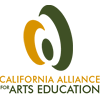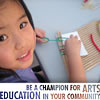Defining High Quality Arts Education
The elements of a high quality visual and performing arts program may be divided into the following focus areas. Indicators of quality in each focus area may be described as follows:1
Standards-Based Curriculum
- The district has a sequential curriculum based on the Visual and Performing Arts Standards adopted by the State of California.
- The visual and performing arts program and standards-based curriculum are clearly articulated throughout the grades levels offered in the district.
Instruction and Methodology
- Instruction is focused on guiding students to standards-based grade-level proficiency in the arts.
- All arts disciplines are offered during the regular school day and are available to all students.
- Instructional methodologies provide individual, small-group and large-group opportunities to study the arts.
- Each arts discipline is delivered as a discrete sequential subject, with its own body of knowledge, skills, and ways of thinking.
- Arts disciplines are authentically integrated into other curricular areas whenever possible.
- The student-to-teacher ratio in each of the arts is appropriate for the delivery of effective instruction.
- The resources and facilities available for each of the arts disciplines are appropriate for the delivery of effective instruction.
Student Assessment
- Assessments capture evidence of the students’ ability to identify, create, describe, compare, analyze, interpret and evaluate their own work and the work of others in relation to the arts standards.
- Assessment in the arts is standards-based and appropriately reflects the essential skills and knowledge that are specific to each art for.
Professional Development
- Those primarily responsible for providing instruction in the arts (multiple subject teachers and arts specialists) as well as those who provide supplemental arts instruction (e.g., teaching artists, volunteers) receive ongoing professional development that is focused on strategies for delivering a standards-based arts education program.
- School and district leaders actively seek out and implement effective professional development models and practices that are appropriate to their local context.
TIP: Looking for professional development ideas? Check out the online resource Designing the Arts Learning Community: A Handbook for K-12 Professional Development Planners: |
Program Administration and Personnel
- The school board adopts a policy supporting arts education for all students.
- The school board and administration develop budgets that support and sustain quality arts programs.
- All teachers primarily responsible for providing arts instruction, as well as others providing supplemental arts instruction, have extensive knowledge and training that qualifies them to teach the arts discipline.
- The district or school has a coordinator for the arts who provides leadership, vision, planning, and resources.
Partnerships and Collaborations
- The visual and performing arts programs provide students with opportunities to attend exemplary exhibits and live performances.
- The visual and performing arts program and curriculum are expanded and enhanced through relationships with artists and artistic resources throughout the community.
Program Evaluation
- Ongoing evaluation of the arts education programs is conducted on a regular basis.
- Arts education programs are developed and refined in accordance with the evaluation results.
Communication and Advocacy
- Arts education program policies, budget development, decisions, and activities are carried out in a transparent, collaborative manner that includes the ongoing involvement of the Community Arts Team.
- School and district leaders regularly communicate with faculty, staff, parents, and the broader community about the value of arts learning in education and progress on the arts plan.
- The district regularly invites local leaders and elected officials to participate in exhibitions and performances of student work, as well as observation of everyday learning in arts classes.
- District arts leadership is aware of current policies and pending legislation related to visual and performing arts instruction in schools, and keeps the community educated and abreast of developments in this area.
TIP: To keep informed about the latest developments in arts education policymaking and legislative action alerts, subscribe to the biweekly e-newsletter ArtsEdMail: |
The workshop script below is designed to help your Community Arts Team explore the Elements of a Quality Arts Education Program. By clearly defining what is required for a quality arts education program, the team can develop a shared language, philosophy, and definition of high-quality arts education for your unique district context. The process helps each team member to be an articulate and passionate advocate for the arts in the district, and lays the groundwork for district policy development in STAGE 3.
Click here [PDF: 212KB] to access a diagram of the Key Components of a Quality Arts Education Program [.pdf], which can serve as a valuable visual aid for your planning team as you assess the quality of your existing arts program.
STAGE 2 WORKSHOP SCRIPT | Elements of a Quality Arts Education Program
Focus Question
Print or write the focus question on a large sheet of paper and affix to the wall. Make sure it is big and bold enough that all participants can view the question easily (see sample below).

Laying the Foundation
Adopting an Arts Education Policy that clearly outlines the expected elements of a quality program is essential to the delivery and sustainability of arts education in a district. The first step in policy development is for each team member to gain a shared understanding of what that actually means by answering the focus question together.
Visualization
Think back to your education experiences — as a student, teacher, administrator, or parent — that have had a profound impact on you. What made the experiences successful? What elements had to be in place for a successful and sustainable outcome?
Brainstorming Ideas
After the visualization, invite the team members to spend a little time brainstorming. Instruct each person to take out a sheet of paper and list 10-12 key elements of a quality arts education program. Ask them to be specific. For example: Ongoing professional development for generalists and arts specialist teachers.
Pair Sharing and Clarifying Ideas
Invite the team members to work in partners and discuss their ideas. Take the clearest ideas and write them out with felt tip marker on half-sheets of paper. The aim is to generate 40-50 ideas among the group. Use the following guide to determine the number of ideas each pair should generate:
10 participants | 5 pairs | 8-9 ideas per pair | 40-45 ideas |
16 participants | 8 pairs | 5-6 ideas per pair | 40-48 ideas |
20 participants | 10 pairs | 4-5 ideas per pair | 40-50 ideas |
To ensure that the ideas are clearly visible to the group when posted, invite the participants to: WRITE BIG, 5-7 WORDS PER SHEET, and 1 IDEA PER SHEET.
Synthesizing the Ideas
Set Up the Wall in Advance
If a sticky wall is not available, you may want to put several sheets of chart paper up on a blank wall.
Put half sheets (vertically) as placeholders across the top of your wall with symbols.
Collect and Organize the First Round of Ideas
The facilitator collects 2-3 half-sheets from each pair. It is helpful to read each idea aloud as you affix it to the wall.
Ask the group: Are there two half sheets that show a similar element? Begin to make vertical columns with pairs of half sheets.
Collect and Organize the Second Round of Ideas
The facilitator collects another round of half sheets from the team members. Continue to read the half sheets as you affix them to the wall.
Continue to categorize them into columns that describe a similar element or idea.
Create a Title for Each Column
Put up a whole sheet of paper at the top of each column and have the group come up with a name that describes the contents of that column.
The title should be 5-7 words and richly descriptive.
Consider the following prompts to help the group name each column:
- What words in this column stand out to you? (Underline the words.)
- What’s your gut reaction/emotional response to the words in this column?
- What are some themes, ideas, insights that this column holds?
- What name best describes what this column is about?Go to a deeper level of consensus rather than just labeling the column; continue until all of the columns are titled.
Closing Conversation
- What stands out to you in our definition of a high quality visual and performing arts program?
- Which of these ideas speaks personally to you?
- Which do you think might be the most difficult to implement or achieve here in our district?
- How might today’s workshop inform the development of our district policy and strategic plan?
This has been important work describing specifically and clearly what we mean when we describe a quality arts education program. Thanks for your insights and participation.
Documentation
The facilitator or a designee should document the results of the Elements of a Quality Arts Education workshop in the form of a table. The findings will be used in the policy development process.
Click here [PDF: 2.64MB] to access sample documentation of the Stage 2 Workshop, which was created using the Table function in Microsoft Word.
1 Adapted from Model Arts Education Toolkit: A Visual and Performing Arts Assessment Process. Sacramento: California Department of Education, 2001.







